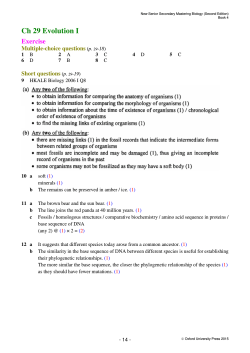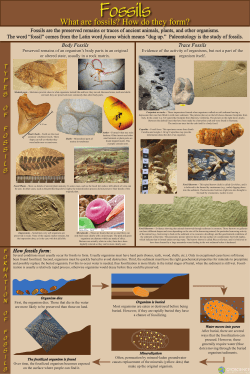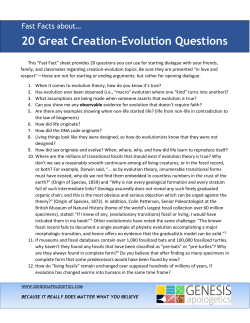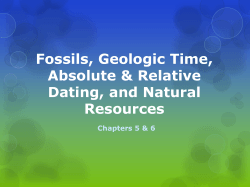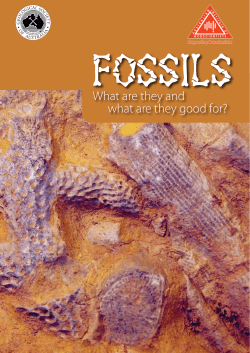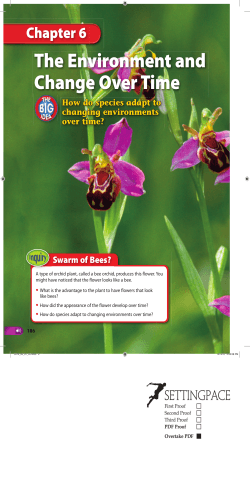
1. Introduction.
TECHNICAL SHEET OF POPULAR SCIENCE PO INTS OF INTEREST: Introduction What are fossils? Factors which affect the fossilization Fossilization Process. Kinds of fossilizations Importance of fossils. Fossils T E C H N I C A L S H E E T N ° 5 J A N U A R Y - J U N E , 2 0 1 4 1. Introduction. Life on Earth began about 3600 million years, because the primitive atmosphere and climate facilitated prebiotic evolution (refers to the formation of life from inorganic substances).ii The first organisms were anaerobic bacteria, its means, that they lived in an environment without oxygen. Later, they were acquiring different metabolic capabilities such as solar energy absorption or up- take of oxygen, between other adaptations, and then came eukaryotic cell. i Unicellular living creatures became to colonial and multicellular organisms giving origin to more complex organisms such as mushrooms, plants and animals. However, this diversity of species has been interrupted by periodic mass extinctions, disappearing countless organisms, so, how is it possible that after thousands, even millions of years, have been preserved to us remains of extinct or presents species, if the daily experience teaches us that living material is very ephemeral? This is possible through the process of fossilization. iii 2. What are fossils? Fossils are the remains, footprints or other evidence of organisms that lived in other geological eras. For example, bones of dinosaurs as his footprints on the wet sand, both are fossil. However, fossils don't just do reference to organisms who lived in other geological eras, but there is also fossil species that are still living today. iv The conservation of organisms depends on the nature of the hard parts of these, for example, in vertebrates, bones and teeth have minerals such as calcium phosphate, which is resistant to decomposition, so it becomes fossilized easily. Instead, in invertebrates the structures resistant to decomposition are shells and exoskeletons of chitin. In the case of plants, Dinosaur fossil (www.planetacurioso.com) cellulose and lignin are what help to fossilizationiv P AGE 2 3. Factors which affect the fossilization Fossilization isn't an isolated event, it's part of a natural cycle in which the sedimentary rocks are formed and depends greatly on other factors such as the physicochemical conditions of the sedimentary environment.v The factors listed below contribute to the quality of the fossil record, making it restricted. .v Decomposers organisms. (letsoor.wordpress.com ) The environment. Not all environments, even being sedimentary, are favorable for fossilization. The biological destruction. Before and after burial, the remains may have been subjected to biological destruction by bacteria, fungi or carrion organisms. ing on the composition of the water passing through currents or by filtration. Most likely preserved organisms living in a sedimentary environment (sea or lake) and those living buried or fixed to the bottom of these places. The mechanical destruction. The transportation of remains causes mechanical destruction, like the disarticulation of skeletal elements to break or abrasion by water or air currents. The chemical destruction. Even after fossilized remains may be destroyed by dissolution, depend- 4. Fossilization Process. Fossilization as Schopf (1975) is the group of chemical and physical changes that result in the preservation of remains which belonged to a living organism. v Immediately after the death of an organism, FOSSILS start the decomposition of their non resistant parts by scavengers like vultures, foxes, hyenas, insects parties start, and mainly by the influence of bacteria, fungi and oxidation . This causes the destruction of such parts and causes fluids and gases during the process. Although this is true even when the body is buried, if this is cover ed by sediments quickly is more likely to fossilize. iv T ECHNICA L SHEET N°5 As the remains of the body are being buried, their holes are filled up by sediment. Then a series of chemical transformations that are slowly replacing organic compounds of these remains to minerals. This transformation depends on the chemical composition of bone or shell, and the sediment containing it, if this combination is favorable, the replacement will be molecule by molecule for a long, long time, until the body is completely mineralized, it means, become stone. vii Diagenesis refers to the physical and chemical processes that affect sedi- P AGE ment after deposit.viii Finally, soil is eroded and exposing the fossil . Fossilization process (expedicionaula.blogspot.com ) 5. Kinds of fossilizations. The following forms of conservation are presented by Schopf (1975). .v Permineralization. It refers to the precipitation of minerals in the porous structure of bones and shells. Authigenic preservation. Precise very fine sediments and precipitation of authigenic minerals (minerals formed by chemical precipitation within the sedimentary deposit). When the body is buried occur a hardening of sediments surrounding it and its cavities are also filled, in this way morphology is preserved by the formation of a protective outer layer. If the remains of the body are dissolved (such as a shell) makes a natural mold, if printing reveals the external morphology of the hard parts, called external mold, if it retains the internal features is known as internal mold. Another example are the marks or traces of organic activity which are called trace fossils (footprints, brands rest, shelters or rooms and metabolism as coprolites. Duripatric preservetion. Original hard parts are conserved by a burial that isolated from the oxidation and decomposition. Mummification. Thus preserved the remains were buried in very arid environments subject to high temperatures, and prevents dehydration decomposition. 3 P AGE 4 Conservation tar. Deposits of tar have substances that make the antiseptic means avoiding spoilage. Chemical fossils. Substances that are residues of the soft parts of organisms which containing carbon compound. Freezing. The drop in temperature prevents microorganisms decompose the remains of living things. Insects in amber. According to Schopf insects in amber have a conservation carbonaceous compression, because only is observed a carbo- External mold of a mollusk (oldearth.wordpress.com ) Permineralization (biblioweb.tic.unam.mx ) Dinosaur footprints in Santisteban del Puerto (www.juntadeandalucia.es) naceous film that keeps the external shape of the remains. Internal mold gastropod (servicios.educarm.es ) Coprolite (fanaticussaurus.blogspot.mx) Head, left arm and shoulder of Ötzi, a man of the Bronze Age (weblogs.clarin.com ) FOSSILS T ECHNICA L SHEET N°5 P AGE Fossil 'Lyuba' a baby mammoth found in Russia (www.elmundo.es ) Insect in amber found in the Amazon (cienciados.com) 6. Importance of Fossils. Fossils help us to know what were the beings that existed in the past and which disappeared and still are today; we also know what was his morphology, their lifestyle and their distribution, and thus help to form evolutionary lineages. The information provided by the fossil record also helps to analyze the ecological factors that govern the distribution of living things and makes it possible to establish the paleoenvironments in which they were deposited.v ogy (science with the study of the earth) as these residues are important for identification of rocks found in coal and oil, in addition to contributing to set their relative ages.iv The study of fossils is very important for geol- 7. Conclusions. The fossils are considered as any evidence of a living being which was preserved through thousands of years. There are several factors during fossilization that influence product quality, making it incomplete. The fossilization process begins with the burial of the remains and then these are part of sediment. We can find different types of fossil according to the form of preservation that they suffered. In general we can say that the fossils are very important because they help to reconstruct the history of the earth, moreover, are a significant source of fuel. 5 8. References. i. Audesirk, T., Audesirk, G., Byers, B. E. Biología . 2008. La vida en la Tierra. 8va/ed. Pearson Educación de México. México. P. 1024. ii. elorigendelavidayelserhumano.blogspot.mx iii. Alonso-Diago, M.A., Sesé-Benito, C. 1988. Historia de la Tierra y de la Vida. Museo Nacional de Ciencia Naturales. España iv. Black, R.M. 1976. Elementos de paleontología. Fondo de Cultura Económica. México. v. García, P., Sour, F., Montellano, M.. 1997. Paleontología. Coordinación de Servicios Editoriales. Facultad de Ciencias, UNAM. México. vi. Patarroyo-Gama, P. 2005. Notas de clase. Principios de Paleontología. Facultad de Ciencias. Universidad Nacional de Colombia. Bogotá, Colombia. TECHNICAL SHEET OF POPULAR SCIENCE Universidad Autónoma de Ciudad Juárez Instituto de Ciencias Biomédicas Programa de Biología Unidad de Exhibición Biológica Calle Pronaf y Estocolmo Sin Número Teléfono 688-18-00 al 09 Extensión 1586
© Copyright 2026
